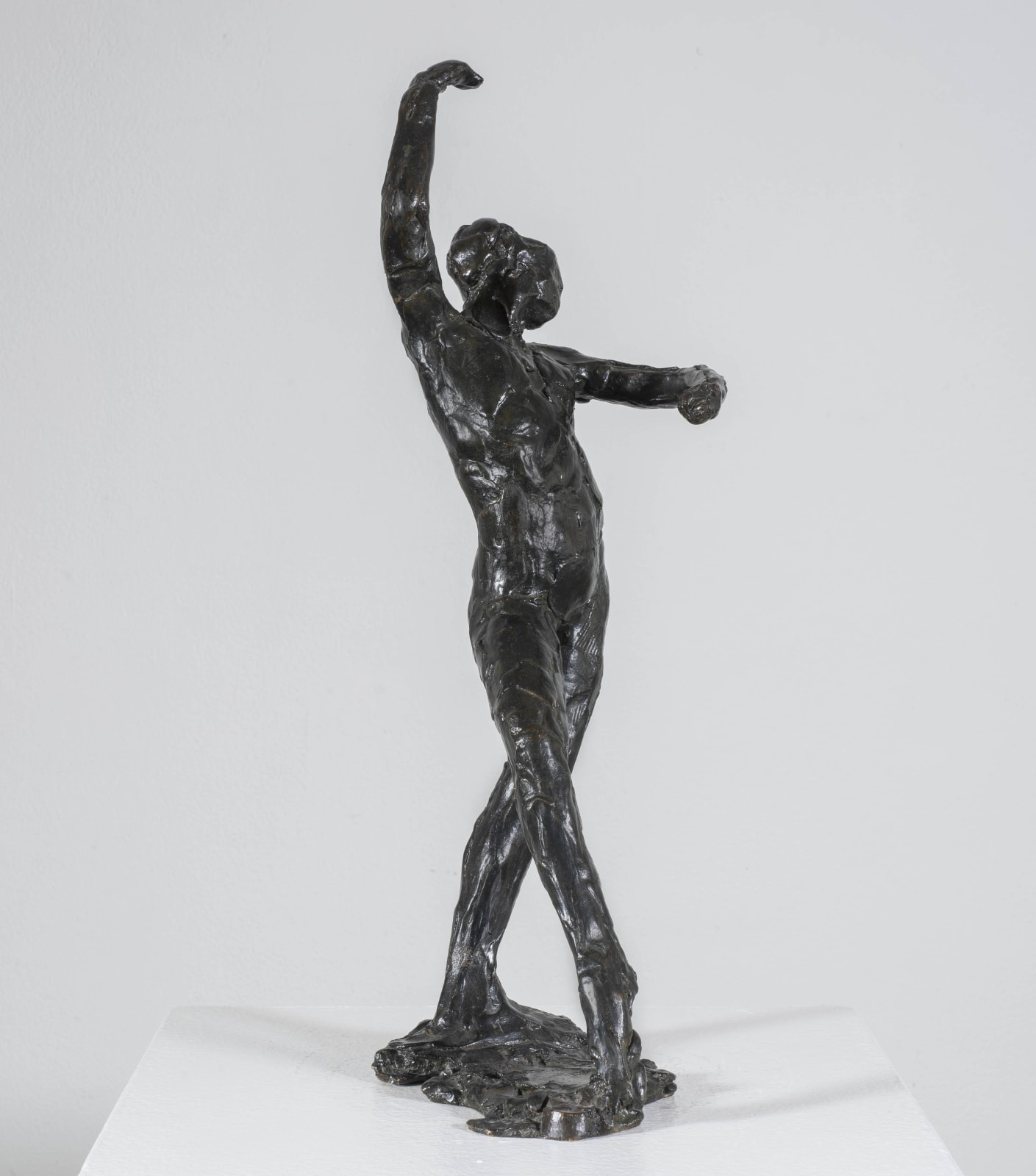-
Artworks
Edgar Degas
Danse espagnole, c.1885Bronze
Conceived circa 1885 and cast between 1919 and 1953 in an edition of 20 numbered A to T plus 2 casts reserved for the Degas heirs marked HER.D and HER by the A. A. Hébrard Foundry, Paris16.26 x 6.9 x 6.5 in, 41.3 x 17.6 x 16.6cmStamped ‘Degas’ (Lugt 658), the foundry mark ‘Cire Perdue A. A. Hébrard’ and numbered ‘20/F’Edgar Degas’ art is inextricably associated with depictions of dancers. They are by some distance his most frequently painted subject matter and the same is also true of his sculpture....Edgar Degas’ art is inextricably associated with depictions of dancers. They are by some distance his most frequently painted subject matter and the same is also true of his sculpture. Of the 74 wax models which have remained and have been cast in bronze, 40 depict dancers in various poses. His art is therefore that of dance, both in subject matter and the lyrical energy which that entails. The present sculpture, ‘Danse espagnole’, however stands out amongst Degas’ three-dimensional works for its spontaneous sense of licence and sensuality, characteristics that clearly relate to its Spanish theme.
By Degas' time, such was the popularity of Spanish dance that European interpretations of traditional Spanish steps were widely incorporated into French balletic productions. Georges Bizet, for example, supplanted colourful folkloric elements into the music, drama and dance of his opera, 'Carmen', which premiered in Paris in 1875. The title of the present work draws upon this ubiquity and the work itself makes a further examination of the intensity and vigour which the Hispanic influence imparted upon classic French dance.
In so much of Degas’ work the nude itself is the subject and the dance is the means by which he can explore the pose, catching it in a moment of abandon. The present work is a prime example of this. With the thick, frenetic modelling in the original wax mould
Degas utterly imbues the work with the dynamism of the dancer, as though working rapidly to capture the movements. Delicately balanced, this work demonstrates a strongly classical understanding of sculptural composition and poise. As Charles Millard has observed in ‘Danse espagnole’ "a spiral configuration that rises through the hip-shot torso, around the curving left arm, turned head, and up through the raised right arm, whence it returned to the body by the relationship of the hand to the head...a sculptural statement of a sophistication unrivalled in the nineteenth century. The curving and spiraling of the forms completely does away with any sense of frontality, and the figure is wholly satisfactory from any angle" (Charles Millard, 'The Sculpture of Edgar Degas', Princeton, 1976, pp. 102-103).
The present work comes with exemplary provenance, having been with Galerie Beyeler, Knoedler & Co., and Richard Feigen, each a resounding testimony to the beauty and quality of the work.
A number of casts are in international museums, including the Metropolitan Museum of Art in New York, Guggenheim Museum in New York, Musée d’Orsay in Paris, Ny Carlsberg Glyptotek in Copenhagen, Detroit Institute of Arts and the Fitzwilliam Museum, Cambridge.Provenance
Galerie Beyeler, Basel (acquired by 1953)
Galerie Georges Moos, Paris
M. Knoedler & Co., New York, 1955 (acquired from the above)
Mrs. Allen Manus, Ontario, May 1956 (acquired from the above)
Private Collection, New Jersey
Richard L. Feigen & Co., New York
Robert Carmel, New York, 1985 (acquired from the above)
Christie's, New York, 13 November 1996, lot 28 (sold by the estate of the above)
Ezra and Cecile Zilkha, New York (acquired from the above)Exhibitions
Basel, Galerie Beyeler, Tableaux français, 1953, no. 33, illus.Literature
J. Rewald, Degas: Works in Sculpture, A Complete Catalogue, New York 1944, no. LXVI, p.130 (another cast illus.)
L. Browse, Degas Dancers, London 1949, no.154, p.388 (another cast illus.)
J. Rewald and L. Von Matt, Degas Sculpture: The Complete Works, Zurich 1957, no. XLVII, p.46 (another cast illus.)
P. Cabanne, Edgar Degas, Paris 1959, p.61 (another cast illus.)
F. Russoli and F. Minervino, L'opera completa di Degas, Milan 1970, no.S16, p.141 (another cast illus.)C. W. Millard, The Sculpture of Edgar Degas, Princeton 1976, no.69 (another cast illus.)
J. and M. Guillaud, Degas: Form and Space, Paris 1984, no.180 (another cast listed and illus.)
R. Gordon and A. Forge, Degas, New York 1988, pp.209 and 278 (another cast listed and illus.)
J. Rewald, Degas's Complete Sculpture: Catalogue Raisonné, San Francisco 1990, no.LXVI, pp.170-171 (other casts illus.)
A. Pingeot and F. Horvat, Degas Sculpture, Paris, Réunion des Musées Nationaux, 1991, no.16, p.160 (another cast listed and illus.)
S. Campbell, Degas: The Sculptures, A Catalogue Raisonné, in Apollo, Vol. CXLII, no.402, August 1995, no.20, pp.20 and 21(another cast illus.)J. S. Czestochowski and A. Pingeot, Degas Sculptures: Catalogue Raisonné of the Bronzes, Memphis 2002, no.20, pp.160-161 (another cast illus.)
S. Campbell, R. Kendall, D. Barbour and S. Sturman, Degas in the Norton Simon Museum, Vol. II, Pasadena 2009, no.51, pp.298-300 (other casts listed and illus.)
S. Lindsay, D. Barbour and S. Sturman, Edgar Degas: Sculpture, Washington D.C. 2010, no.20, pp.156-161 and 369 (wax cast listed and illus.)1of 3
